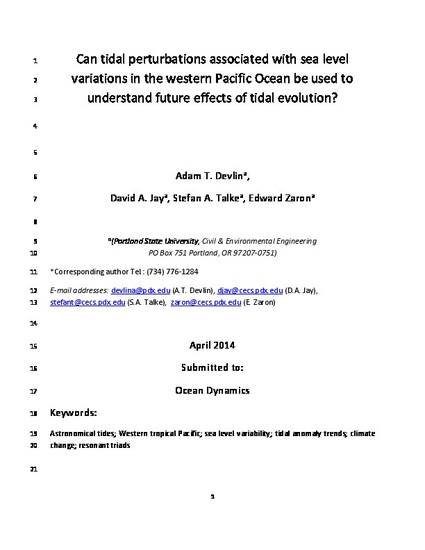
- Intertidal ecology -- Pacific Ocean,
- Tides,
- Energy transfer
This study examines connections between mean sea level (MSL) variability and diurnal and semidiurnal tidal constituent variations at 17 open-ocean and 9 continental shelf tide gauges in the western tropical Pacific Ocean, a region showing anomalous rise in MSL over the last 20 years and strong interannual variability. Detrended MSL fluctuations are correlated with detrended tidal amplitude and phase fluctuations, defined as tidal anomaly trends (TATs), to quantify the response of tidal properties to MSL variation. About 20 significant amplitude and phase TATs are found for each of the two strongest tidal constituents, K1 (diurnal) and M2 (semidiurnal). Lesser constituents (O1 and S2) show trends at nearly half of all gauges. Fluctuations in MSL shift amplitudes and phases; both positive and negative responses occur. Changing overtides suggest TATs are influenced by changing shallow water friction over the equatorial Western Pacific and the eastern coast of Australia (especially near the Great Barrier Reef). There is a strong connection between semidiurnal TATs at stations around the Solomon Islands and changes in thermocline depth, overtide generation, and the El Niño Southern Oscillation (ENSO). TATs for O1, K1 and M2 are related to each other in a manner that suggests transfer of energy from M2 to the two diurnals via resonant triad interactions; these cause major tidal variability on sub-decadal time scales, especially for M2. The response of tides to MSL variability is not only spatially complex, it is frequency dependent; therefore, short-term responses may not predict long-term behavior.
Available at: http://works.bepress.com/stefan_talke/20/

This is the author’s version of a work that was accepted for publication in Ocean Dynamics. Changes resulting from the publishing process, such as peer review, editing, corrections, structural formatting, and other quality control mechanisms may not be reflected in this document. Changes may have been made to this work since it was submitted for publication. A definitive version was subsequently published in Ocean Dynamics, Vol. 64 Issue 8, 2014 and can be found online at: http://dx.doi.org/10.1007/s10236-014-0741-6